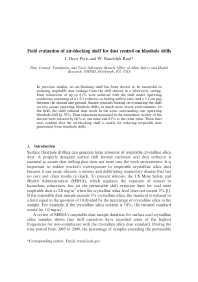Mining Publication: Field Evaluation of Air-blocking Shelf for Dust Control on Blasthole Drills
Original creation date: March 2011
In previous studies, an air-blocking shelf has been shown to be successful in reducing respirable dust leakage from the drill shroud in a laboratory setting. Dust reductions of up to 81 percent were achieved with the shelf under operating conditions consisting of a 1.9:1 collector-to-bailing airflow ratio and a 5.1-cm gap between the shroud and ground. Recent research focused on evaluating the shelf on two actual operating blasthole drills, in much more severe environments. In the field, the shelf reduced dust levels in the areas surrounding one operating blasthole drill by 70 percent. Dust reductions measured in the immediate vicinity of the shroud were reduced by 66 percent at one mine and 81 percent at the other mine. These field tests confirm that the air-blocking shelf is useful for reducing respirable dust generation from blasthole drills.
Authors: JD Potts, WR Reed
Peer Reviewed Journal Article - March 2011
NIOSHTIC2 Number: 20039267
Int J Min Reclam Environ 2011 Mar; 25(1):32-40
See Also
- Best Practices for Controlling Respirable Dust in Coal Mines
- Best Practices for Dust Control in Metal/Nonmetal Mining
- Controlling Respirable Dust in Underground Coal Mines in the United States
- The Effects of Water Spray Placement for Controlling Respirable Dust and Face Methane Concentrations
- Field Assessment of Control Techniques and Long-Term Dust Variability for Surface Coal Mine Rock Drills and Bulldozers
- Improved Drill Shroud Capture of Respirable Dust Utilizing Air Nozzles Underneath the Drill Deck
- Laboratory Evaluation of Shield Dust Entrainment in High-Velocity Airstreams
- Laboratory Testing To Quantify Dust Entrainment During Shield Advance
- Performance of a Light Scattering Dust Monitor at Various Air Velocities: Results of Sampling in the Active Versus the Passive Mode
- Respirable Dust
- Status of a Tapered Element, Oscillation Microbalance-Based Continuous Respirable Coal Mine Dust Monitor
- Content source: National Institute for Occupational Safety and Health, Mining Program


 ShareCompartir
ShareCompartir
